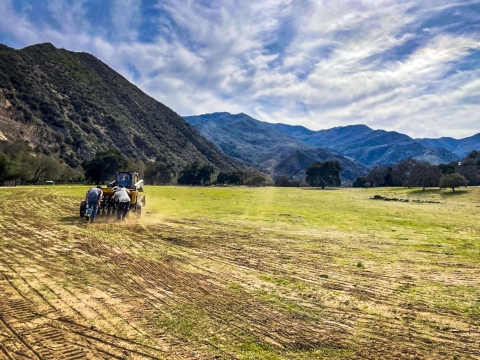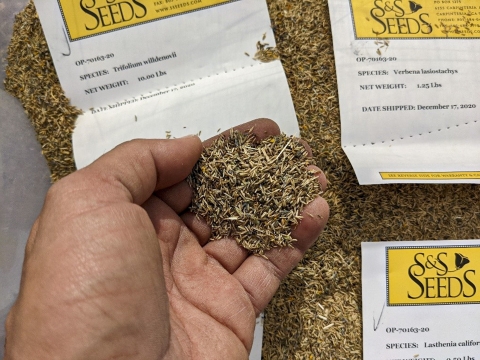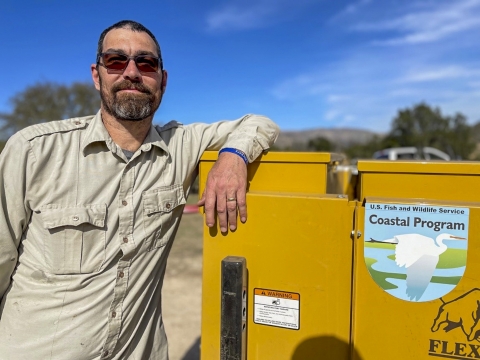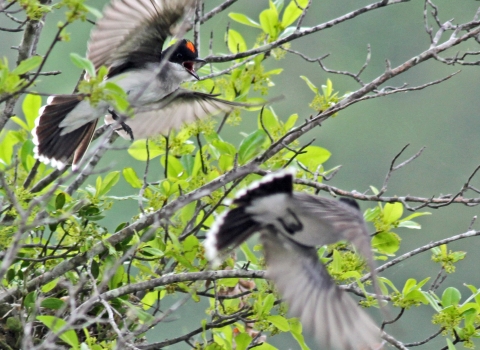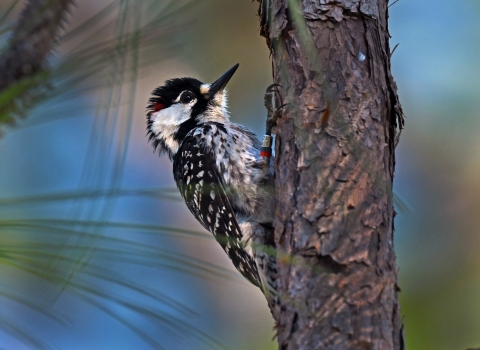By Olivia Beitelspacher
In February of this year, the U.S. Fish and Wildlife Service and Big Sur Land Trust completed a 5-acre pilot drill seeding project at the Arroyo Seco Ranch, west of Greenfield, California. This seeding project marks the beginning of a long-term goal to establish “waystations” for monarch butterflies and other pollinators along the Central California coast.
Arroyo Seco Ranch had been managed as a livestock grazing operation for generations, which maintained the area as a grassland with native grass and flowering plant species that provided good pollinator habitat. However, during the Dolan Fire in 2020, the area was used as a base for firefighters and firefighting equipment which resulted in compacted soil and very little grass cover remaining. After the fire, the Land Trust was reimbursed to help restore pollinator habitat that was damaged by the firefighting activities.
“The drill seeding project was located within the footprint of the firefighting base and aimed to re-establish the native plants important for habitat value, improve soil health, increase the amount of healthy forage for cattle and counter the invasive weed species that threaten the site,” said Patrick Riparetti, Director of Stewardship for Big Sur Land Trust.
A drill seeder uses special technology that places seeds directly into the soil with very little ground-disturbance. The Truax seeder used in this project accommodates three seed types (large, small and fluffy) in three separate containers that can be calibrated individually to provide the most effective seeding rate (pounds per acre) to achieve a particular seed mix.
The Service provided funding for the drill seeder and the Land Trust provided the seed, including blue wild rye, California brome, purple needle grass, tomcat clover, western vervain, Spanish clover, tidy tips, California goldfields, and Sandberg bluegrass. All these species are ideal for supporting pollinators. Future seeding projects will also include native milkweed for monarch butterflies.
“The primary focus with these projects is to plant native flowering plants,” said Shawn Milar, coastal program coordinator for the U.S. Fish and Wildlife Service along the Central California coast. “Most important in our geography are early-flowering plants for monarchs that are heading east after leaving overwintering sites along the coast.”
Most of the world’s flowering plants depend on pollinators – small insects and birds that help spread seeds - to survive. Although the work of pollinators is extremely important, their numbers have been dropping in recent years.
Monarchs in particular have experienced a dramatic decline. The migratory western monarch population has declined by more than 99 percent since the 1980s. Approximately 4.5 million monarchs overwintered on the California coast in the 1980s, whereas in 2020, the population estimate for overwintering monarchs was less than 2,000 butterflies.
“This extreme drop in numbers is likely due to multiple stressors across the monarch’s range,” said assistant field supervisor Cat Darst. “Some of these stressors include the loss and degradation of overwintering groves; loss of breeding and migratory habitat; climate change climate change
Climate change includes both global warming driven by human-induced emissions of greenhouse gases and the resulting large-scale shifts in weather patterns. Though there have been previous periods of climatic change, since the mid-20th century humans have had an unprecedented impact on Earth's climate system and caused change on a global scale.
Learn more about climate change ; parasites and disease; and pesticide use, particularly insecticides.”
Because pesticide use and habitat loss are two of the driving forces behind monarch population decline, creating pesticide free habitat is a priority for recovery. Planting native, pesticide-free milkweed and flowering plants is a way that everyone can participate in the effort to save imperiled pollinators, including monarchs.
Since habitat restoration is key for species recovery, Milar is hopeful that the seeder will continue to be used to plant native species and create new pollinator habitat along the central coast. The Service will manage use of the seeder each year on a priority basis, and Milar will offer training on its use to more biologists within the Service. As interest grows, there is hope that more partnerships will be developed, and more projects will be completed in the near future.
“The Service provided essential equipment and technical expertise that saved us time and money and resulted in a better outcome” said Riparetti. “It's great to work with partners who are so knowledgeable about the natural resources and well-versed in practical and strategic applications to help achieve our goals.”
“We’re grateful to our partners and we look forward to more successful seedings in the future,” said Milar. “I would like to have the seeder rolling as much as possible, building a network of “waystations” for monarch butterflies and other pollinators. My hope is that we can get a few hundred acres planted and growing for spring 2022.”
With tools like the seeder, the future is looking bright for pollinators.
“We are thrilled about the new seeder,” said Riparetti. “It was exciting to witness its maiden voyage at Arroyo Seco Ranch, and it’s a great investment for the future.”

